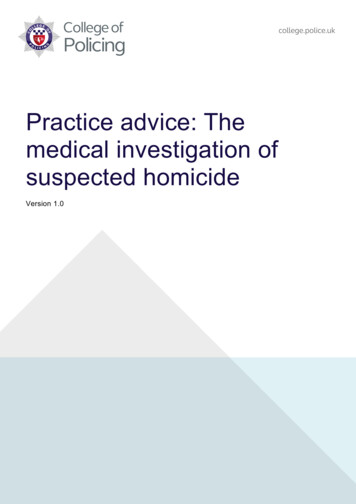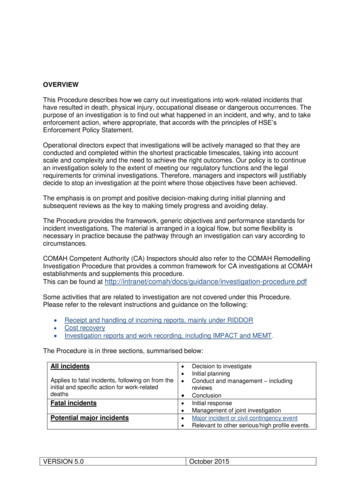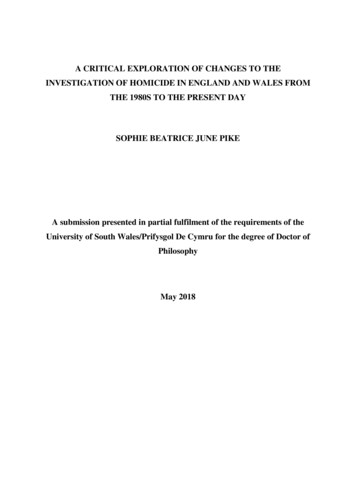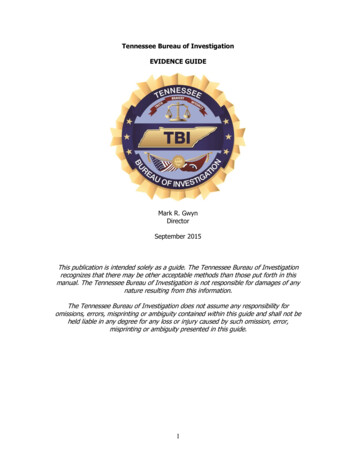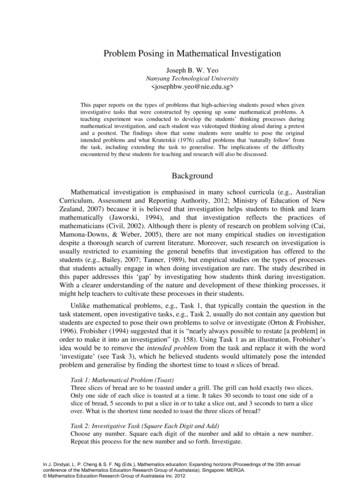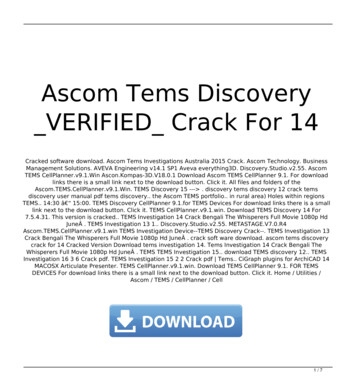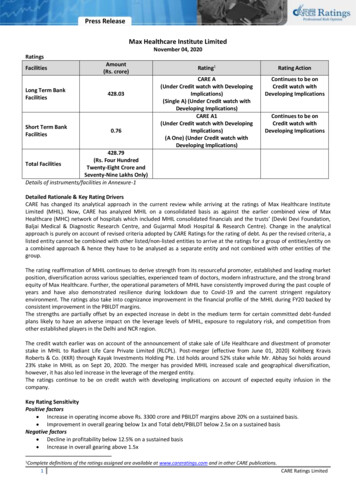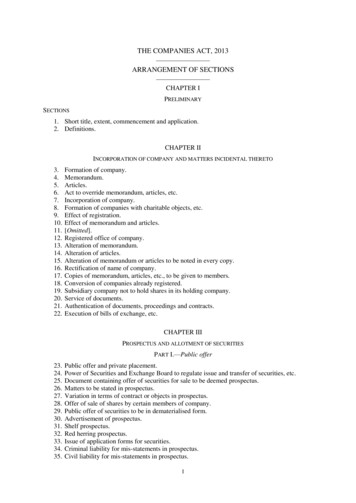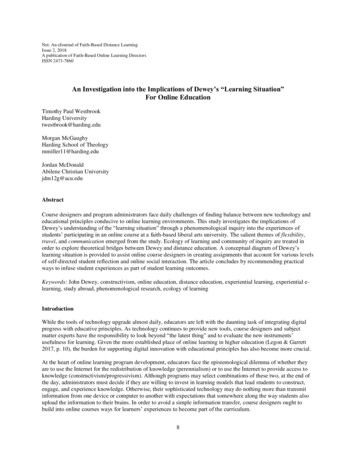
Transcription
Net: An eJournal of Faith-Based Distance LearningIssue 2, 2018A publication of Faith-Based Online Learning DirectorsISSN 2473-7860An Investigation into the Implications of Dewey’s “Learning Situation”For Online EducationTimothy Paul WestbrookHarding Universitytwestbrook@harding.eduMorgan McGaughyHarding School of Theologymmiller11@harding.eduJordan McDonaldAbilene Christian Universityjdm12g@acu.eduAbstractCourse designers and program administrators face daily challenges of finding balance between new technology andeducational principles conducive to online learning environments. This study investigates the implications ofDewey’s understanding of the “learning situation” through a phenomenological inquiry into the experiences ofstudents’ participating in an online course at a faith-based liberal arts university. The salient themes of flexibility,travel, and communication emerged from the study. Ecology of learning and community of inquiry are treated inorder to explore theoretical bridges between Dewey and distance education. A conceptual diagram of Dewey’slearning situation is provided to assist online course designers in creating assignments that account for various levelsof self-directed student reflection and online social interaction. The article concludes by recommending practicalways to infuse student experiences as part of student learning outcomes.Keywords: John Dewey, constructivism, online education, distance education, experiential learning, experiential elearning, study abroad, phenomenological research, ecology of learningIntroductionWhile the tools of technology upgrade almost daily, educators are left with the daunting task of integrating digitalprogress with educative principles. As technology continues to provide new tools, course designers and subjectmatter experts have the responsibility to look beyond “the latest thing” and to evaluate the new instruments’usefulness for learning. Given the more established place of online learning in higher education (Legon & Garrett2017, p. 10), the burden for supporting digital innovation with educational principles has also become more crucial.At the heart of online learning program development, educators face the epistemological dilemma of whether theyare to use the Internet for the redistribution of knowledge (perennialism) or to use the Internet to provide access toknowledge (constructivism/progressivism). Although programs may select combinations of these two, at the end ofthe day, administrators must decide if they are willing to invest in learning models that lead students to construct,engage, and experience knowledge. Otherwise, their sophisticated technology may do nothing more than transmitinformation from one device or computer to another with expectations that somewhere along the way students alsoupload the information to their brains. In order to avoid a simple information transfer, course designers ought tobuild into online courses ways for learners’ experiences to become part of the curriculum.8
IMPLICATIONS OF DEWEY AND ONLINE EDUCATION9John Dewey recognized the significant role real-life experiences play on learning. Dewey drew from Romanticphilosophers, such as Rousseau, Pestalozzi, and Froebel, and applied their principles of sensory experience to histwentieth-century American context (Dewey, 1916). His aim was to explore ways of learning for the benefit ofeducation as a discipline (Dewey, 1938). As institutions of higher learning bring online academics toward themainstream of education, they should consider how Dewey’s principles of experience apply to today’s context. Thepurpose of this article is to invite distance educators to consider how Dewey’s understanding of learning byexperience affects online course design. In order to explore the role of experience in online learning, this studyconducted a phenomenological analysis of student experiences from an online course. The analysis was guided bythe following research question: “In what ways does the interaction of past experiences and present communityimpact learning online?” The student feedback revealed flexibility, travel, and communication as important themesthat support Dewey’s “learning situation” as a theoretical framework for experiential learning online.Related LiteratureA growing body of recent literature on distance learning emphasizes the importance of social learning andinteraction in online education (see Thor et al., 2017; Howell et al., 2017; Westbrook, 2015). Carver, King, Hannum,and Fowler (2007), by focusing on experiential e-learning (or eelearning), introduce important concepts for joiningexperience and learning at a distance, such as “learner-centric,” “agency,” and “belongingness.” They suggest a sixlevel taxonomy for experiential e-learning: type 1 “content sharing,” type 2 “online conversation,” type 3“meaningful online conversation,” type 4 “drawing on student experiences,” type 5 “problem-based/servicelearning,” and type 6 “direct experience/action learning.” The authors conclude that “the addition of concepts fromexperiential education can bolster e-learning environments,” especially given that experiential e-learning helpsstudents overcome some of the challenges of learning in isolation (Carver et al., 2007, p. 255). Following their lead,Baasanjav (2013) overlays Kolb’s Experiential Learning Theory onto these “eelearning core concepts” and appliesthis integration of theory to an online course design. Bartley (2006, p. 23) calls for assessment strategies that are“interactive and engaging.” Collins and Halverson (2009) promote the “lifelong-learning era” that echoes theprogressive movement of the twentieth century in light of innovative developments in computer technology. Theywrite, “The pedagogy of the lifelong-learning era is evolving toward reliance on interaction ” (p. 97). Conrad andDonaldson (2004), drawing from the work of Dewey, Bruner, Vygotsky, and Piaget, insist that online pedagogyincorporate social constructivism in order to avoid courses’ becoming merely “digital correspondence” courses (p.6). Koontz, Li, and Compora (2006) write, “The implementation of a constructive environment online can be donethrough the process of discovery learning. This constructive approach is necessary in Web-based instructionbecause students are forced to access, retrieve, reconstruct, adapt, and organize information in a way that ismeaningful to their learning” (p. 27). Mason and Rennie (2008) point toward interactive interfaces and“connectivism” as the way forward “for learners to flourish in a digital era” (p. 19). It should come as no surprisethat progressive modes of delivery utilize progressive theories of education. The challenge for the road ahead will befor online enthusiasts to ground innovative design with objective assessment and theoretical exploration.Cassady and Mullen (2006) explore electronic field trips (EFT) as a means to enhance the learning experience foronline students. They report how Ball State University, in conjunction with institutions such as The SmithsonianInstitute and National Aeronautics and Space Administration (NASA), has created EFTs that incorporate livebroadcasts, simulations, online games, discussion boards, and teaching materials. The design of the EFTs creates alearner-centered environment, following a constructivist model. Cassady and Mullen (2006, p. 151) evaluate theEFTs by implementing Bruce and Levin’s (1997, pp. 82-91) adaptation of Dewey’s (1900, pp. 59-61) naturalimpulses of learning (“inquiry,” “communication,” “construction,” and “expression”). They conclude that theseimpulses provide a taxonomy that helps administrators in distance education create a “coherent framework” forresource selection and EFT design (Cassady & Mullen, 2006, p. 159).Addressing the problem that not all students everywhere have access to elite museums and research centers, the EFTexperiment successfully demonstrates how an interactive museum experience open to all students via the Internetgenerates natural inquiry, allows for educative communication, and lends itself to constructive learning. However,the study also recognizes how the gap in time and space for asynchronous learners limits the efficacy of EFTs in theconstruction and expression domains (Cassady & Mullen, 2006, pp. 157-160).While images alone may conjure emotive inquiry from students, visual representation does not replace the fullsensory experience of physically being at a site. In one example, the authors describe how students’ watching high-
IMPLICATIONS OF DEWEY AND ONLINE EDUCATION10definition imagery of the Grand Canyon conjures similar responses to the monument as a personal visit would.Although the Grand Canyon’s beauty may be enjoyed on video or in pictures, an experience of the Grand Canyonlimited to audio and video is not the full Grand Canyon experience. A picture or even motion picture does not comeclose to the sensation of one’s standing on the rim trail with amazement and realizing that her or his senses cannotabsorb the canyon’s width and depth. While computer programmers continue to improve “sensory-filledexperiences” (Wagner, 2006, p. 49), a simulated experience merely imitates the in-person experience.In contrast to digital field trips, study abroad programs actually place students in 3-dimensional laboratories inwhich the students are experiencing new cultures, languages, and historical sites. Savicki’s (2008) multi-authoredbook provides studies in which students in these study abroad programs document their learning of interculturalcompetency from real-time and real-life experiences. Selby writes, “.study abroad students experience somethingthat is truly transformational” (2008, p. 1). While students personally process intercultural experiences, the facultyon the trip offer “purposeful intervention” that helps students make the most of their overseas learning encounters(Lou & Bosley, 2008, p. 282). The interest of this current study is to explore the role of experience and onlineeducation, and, as is described below, several of the participants were taking an online class about culture whileattending study abroad programs. The connection, then, is to consider how both face-to-face encounters and digitallearning environments may be bridged as experiential resources for learning.Lowe and Lowe’s (2010) application of Bronfenbrenner’s (1979) ecology of human development to distanceeducation offers the framework for considering this bridge between digital connections and one’s personal face-toface interactions. Intending to address the American Theological Society’s (ATS) standards for spiritual formationin distance programs, Lowe and Lowe suggest that distance education courses draw from students’ greater socialnetwork for transformation and learning. They write, “Ecological diversity, whether biological, social, or spiritual,creates an enriched environment that stimulates beneficial interaction among living organisms similar to thesapiential observation that ‘iron sharpens iron, as one person sharpens another’ (Prov 27:17, Today’s NewInternational Version)” (Lowe & Lowe, 2010, p. 90).Comparing the ecological environment to a set of nested Russian dolls, Bronfenbrenner suggests four systems thatenvelop an individual’s development: the microsystem, mesosystem, exosystem, and macrosystem. He describes themost immediate connections or interactions with others as the microsystem (Bronfenbrenner, 1979, p. 22). Themesosystem he describes as “interrelations among two or more settings in which the developing person activelyparticipates” (p. 25). The exosystem includes events, activities, and settings that have an effect on an individualthough he or she is not an active participant (p. 25). The macrosystem comprises a collection of the three lowersystems that form continuities, or “consistencies,” at the subcultural or cultural level (p. 26).Lowe and Lowe (2010, p. 93) regard the interaction, or interconnectedness, in Bronfenbrenner’s theory as helpful toenvisioning successful online learning. The term “connection” has obvious links to online education; indeed, theInternet has taken interconnectedness to a new dimension. Lowe and Lowe (2010, p. 98) correctly point toward thestudents’ ecological environment as a resource for learning, noting how one’s family, church, and communityprovide social interaction that has educative value. As distance educators and administrators design and implementonline curricula, they ought to give careful thought to how each student can perceive his or her immediatesurroundings as possible sources of social learning and enhanced sensory perception, thus moving away from thereal-world versus school-world separation (Roberts, 2007, p. 225).A form of education that integrates online and face-to-face learning is blended learning, an integration thatapproaches a paradigm for applying Dewey’s educative experience with distance education (Graham, 2006, p. 3).Garrison and Vaughan (2008, pp. 17-29) speak of the community of inquiry that grows out of three types ofpresence: social presence, teaching presence, and cognitive presence. Social presence online exists when courseparticipants project themselves authentically into online space through forums, blogs, or in other forms ofcommunication. Teaching presence joins content and design with the scaffolding of the facilitator. Students alsoparticipate in the teaching presence when they make valuable contributions to discussions. One may describe thecognitive presence as the “aha” moments, meaningful exchanges, measurable integration of course materials, andother events where learning occurs. These three overlapping domains comprise the educational experience, resultingin a community of students and teachers engaged in inquiry and learning.
IMPLICATIONS OF DEWEY AND ONLINE EDUCATION11While all three of these domains may exist in pure face-to-face and online courses, both modes of delivery havedifferent strengths. Garrison and Vaughan (2008) write, “It is our experience that the communication media do havedifferent advantages. Therefore, educators need to consider which phases of an educational task are best conductedin an online or face-to-face environment” (p. 37). To use social presence as an example, while online discussionslend themselves to a safe, trusting environment for students to explore deep thinking, face-to-face collaborationtends to result in higher levels of interaction (Hawkes & Romiszowski, 2001, p. 287). A well-designed blendedcourse, then, consists of elements for face-to-face collaboration as well as online forums for individual and studentto-student reflection.John Dewey’s View of ExperienceA tendency for education historically has been to create a dichotomy between traditional and student-centeredmodels of learning. John Dewey, however, advised against “either-or” approaches to education (Dewey 1938, p. 21).At a time when traditional curriculum was challenged by utilitarian impulses (Cremin, 1961, p. viii), Dewey's appealprovided balance between information exchange and real world application. In his classic history of the ProgressiveMovement, Cremin acknowledges the lasting effects left by these efforts:. granted the collapse of progressive education as an organized movement, there remained a timelessnessabout many of the problems the progressives raised and the solutions they proposed. The ProgressiveEducation Association has died, and the progressive education itself needed drastic reappraisal. Yet thetransformation they had wrought in the schools was in many ways as irreversible as the larger industrialtransformation of which it has been part (1961, pp. 352-353).One cannot deny the ways the Progressive Movement transformed American schools. With the incorporating of aholistic approach to curriculum, the influence of social science theories, and initiatives to reduce social class bias inthe school system, today’s students and teachers stand on the shoulders of theorists and practitioners who sought abetter way to teach children in a democratic society.The Post-Enlightenment era and Romanticism created a climate in which innovators such as Rousseau, Pestalozzi,and Froebel would develop learner-centered models of education. However, other forces of the times, such as theIndustrial Revolution, immigration, urbanization, and poverty, stifled child-centered education, leading toward aproduct-centered, or factory model. Thus, the old guard of tradition devalued learning by experience.Toward the end of the 19th century, the growing pains of a developing nation rekindled interest in education that waspractical and accessible to the working class and immigrants. For example, Francis W. Parker undertook a reform ofthe Quincy, Massachusetts, schools. According to Cremin, Dewey regarded Parker as the “father of progressiveeducation” (1961, p. 21). In 1893, Joseph Mayer Rice challenged traditional schools with his book The PublicSchool System of the United States (Rice, 1893; see Reese, 2001). Educators in this movement took seriously socialconcerns, and its leaders revisited school systems as a means to “Americanize” the children of the working class andimmigrants in proper manners, in ethics, and in pursuit of American democracy (see Cremin 1961, pp. 66-89).Shapiro writes, “No symbol of humanitarianism was more meaningful to progressives than childhood” (Shapiro,1983, p. 171).Effects of Progressivism could be seen ubiquitously. Gamson records Frank Cooper’s initiatives in Seattle,Washington, from 1901 to 1922. Cooper encouraged the implementation of “active learning” and “creative play”(Gamson, 2003, p. 422). Wallace (2006) documents Angelo Patri’s child-centered reforms in New York City duringthe Great Depression and leading up to World War II. In 1907 in Gary, Indiana, William Wirt developed a workstudy plan that brought “hands-on” learning to traditional curriculum (Volk, 2005). It was during this era thatphilosopher John Dewey sifted through the period’s cries and offered a balanced voice, assimilating learning byexperience into a traditional system.As a “pragmatic naturalist,” Dewey addresses the paradigm shift that eighteenth century writers, such as Rousseau,brought forth (Eames, 1977; Noddings, 2012, p. 26). He writes, “The seeming antisocial philosophy was asomewhat transparent mask for an impetus toward a wider and freer society. The emancipated individual was tobecome the organ and agent of a comprehensive and progressive society” (Dewey 1916, p. 59). He also creditsRousseau, Pestalozzi, and Froebel for originating the emphasis of natural education in early learning (Dewey 1916,
IMPLICATIONS OF DEWEY AND ONLINE EDUCATION12p. 74). According to Dewey, natural education was a reaction against the Protestant doctrine of total depravity,where nature was regarded as God’s work and social interference of God’s divine plans was “the primary source ofcorruption in individuals” (1916, p. 73). Although Dewey regards this view as an oversimplification, heacknowledges the value of natural education’s quest to overturn the powers of injustice when he writes, “It is theaim of progressive education to take part in correcting unfair privilege and unfair deprivation, not to perpetuatethem” (1916, p. 76).Dewey gleans from the experiential impulse of natural education: “An ounce of experience is better than a ton oftheory simply because it is only in experience that any theory has vital and verifiable significance” (1916, p. 90).Dewey also writes, “In critical moments we all realize that the only discipline that stands by us, the only trainingthat becomes intuition, is that got through life itself” (Dewey, 1900, p. 31). Learning from experience, then, beginswith the senses of the student: “The senses—especially the eye and the ear—have to be employed to take in what thebook, the map, the blackboard, and the teacher say” (1916, p. 88). The senses serve as “external inlets and outlets ofthe mind,” conducting information exchanges between material objects and the mind (1916, p. 89). In Dewey’swords, “To ‘learn from experience’ is to make a backward and forward connection between what we do to thingsand what we enjoy or suffer from things in consequence” (1916, pp. 87-88).If sensory perception leads to learning, then one would reason that learning experiences ought to focus on makingsensory impressions. In Experience and Education Dewey certainly takes this view. He offers childhood recess as anexample of children’s learning rules for schoolyard games as they negotiate social guidelines (Dewey, 1938, pp. 5253). Reminiscent of Friedrich Froebel’s kindergarten, Dewey writes, “The planning must be flexible enough topermit free play for individuality of experience and yet firm enough to give direction towards continuousdevelopment of power” (Dewey, 1938, p. 58; 2005, pp. 135, 174). He even echoes Romanticism’s sentiment onloose clothing as an aid to learning in this critique: “Strait-jacket and chain-gang procedures had to be done awaywith if there was to be a chance for growth of individuals in the intellectual springs of freedom ” (Dewey, 1938, p.61; Froebel, 1906, pp. 60, 63; Rousseau, 1979, p. 43). In other words, children learn through sensory perception, andprohibiting their movement, such as when bundling infants, limits their experiments and experiences with the world.According to Dewey, education has an organic connection with students’ experiences; yet not all experiences benefitthe student, or in Dewey’s terms, are “genuinely educative” (1938, p. 25). Experience alone does not educate; ratherthe depth of the learning depends on the quality of the experience. Dewey refers to this range of experiences as the“experiential continuum” (1938, p. 28). Even traditional education, he says, gives “a plethora” of experiences, butunless students achieve learning outcomes from those experiences, the unintentional, traditional exercise falls shortof a quality educative experience (1938, p. 26). Dewey presents two criteria for an experience to be educative:continuity and interaction. An experience satisfies continuity when students adapt something from the past in a waythat benefits the future (1938, p. 35). Interaction involves the individual or individuals who guide, facilitate, andscaffold learning (1938, p. 42). When continuity and interaction intersect, according to Dewey, a learning“situation” occurs (1938, p. 43).Figure 1 illustrates how the learning situation results when one’s interaction with the object to be learned intersectswith the learner’s experience. The vertical axis indicates the continuum between one’s self-reflection and interactionwith another person, place, or event. The greater the contact from facilitators, classmates, and individuals from one’scontext, the less students reflect in order to assimilate new information. The inverse is also true. The more studentsspend reflecting on their own, the less their learning includes feedback from others. The continuity of experienceline indicates educative experiences from the past and anticipates experiences in the future. The arrows show howthe learning situation does not occur only once, but rather repeats throughout one’s intellectual growth (Roberts,2007; see also Kolb 1984, 22-23). Depending on the subject matter and the needs of the students, the horizontal linemoves up or down. The spiral illustrates the non-sequential and unpredictable nature of deep thinking.
IMPLICATIONS OF DEWEY AND ONLINE EDUCATION13Figure 1. An Adaptation of Dewey’s Learning SituationWhile learning begins with the senses, an educative experience also requires reflection: “Thought or reflection . isthe discernment of the relation between what we try to do and what happens in consequence. No experience havinga meaning is possible without some element of thought” (Dewey, 1916, p. 90). In order to direct reflection towardgrowth in understanding, Dewey suggests a five-step method for an intentional reflective experience rather than atrial-by-error approach to thinking, echoing the scientific method and anticipating the accommodation andassimilation components of cognitive stage-theory. The five steps are listed below:1. “Perplexity, confusion, doubt, due to the fact that one is implicated in an incomplete situation whose fullcharacter is not yet determined.”2. “A conjectural anticipation—a tentative interpretation of the given elements, attributing them to atendency to effect certain consequences.”3. “A careful survey (examination, inspection, exploration, analysis) of all attainable consideration whichwill define and clarify the problem in hand.”4. “A consequent elaboration of the tentative hypothesis to make it more precise and more consistent.”5. “Taking one stand upon the projected hypothesis as a plan of action which is applied to the existing stateof affairs: doing something overtly to bring about the anticipated result, and thereby testing the hypothesis.”(Dewey, 1916, p. 93)Thus, students reflect when they attempt to make sense of inconsistencies in their experiences (Dewey, 2005).Haphazard, trial-by-error reflection does not benefit student learning as much as intentional exploration of thought.Reflection with a purpose enhances thinking and creates ways for students to understand, apply, and own newcontent.Dewey’s concept applied to distance education helps course designers to evaluate their decisions when organizingcontent, creating online interactions, and exploring other ways for students to achieve learning outcomes. A forumpost that encourages collaboration between students and facilitators would target a learning situation toward themiddle of the interaction axis. Online journaling, intended to encourage self-reflection, would fall lower on theinteraction line. For both forums and journals, carefully crafted prompts and questions are to summon studentexperience as a tool for understanding new concepts.
IMPLICATIONS OF DEWEY AND ONLINE EDUCATION14A century after Dewey challenged traditional education, causing educators to rethink how they write curriculum,teach, and value the child’s role in the learning process, his theory continues to guide course developers in the digitalage toward learning strategies that take into account how people think in addition to what content must betransmitted. Dewey’s caution for balance remains timeless: “. it is not of new versus old education nor ofprogressive against traditional education but a question of what anything whatever must be to be worthy of the nameeducation” (1938, p. 90).Research DesignThis current study applied Dewey’s theoretical framework of continuity of experience and interaction to aphenomenological analysis of student learning online. A single online class from a private liberal arts university wasselected. Although a single course as the primary source of data could be viewed as a limitation, the interest of thestudy was more focused on the intersection of experience and online learning than the actual case itself. Merriam(2009, p. 48) refers to this type of qualitative research as an “instrumental case study,” in that the examination of aparticular case provides information about a process that has transferable qualities beyond the case. By applyingDewey’s “learning situation” to contextual matters of online learning, the following research question guided thedata collection and analysis:RQ: “In what ways does the interaction of past experiences and present community impact learningonline?”After obtaining permission from the Institutional Research Board of the participating university (kept on file), theresearchers proceeded to identify the case for the investigation. They chose a single course from a private, liberalarts, faith-based school for the following reasons. First, the course contained learning outcomes that includedintercultural competencies, which by definition suggested extra-course experiences. Second, this course had builtinto the design assignments that required reflection on lived experiences of the students. Third, the participatingstudents were a blend of international students, adult learners in the United States, and U.S. American study-abroadstudents. The study examined the individual experiences of participants who were sharing in common educationalactivities that spanned across international locations. Confidentiality of participants was strictly protected throughoutthe process.The selected course is taught online three times a year, and class size ranges from 10 to 40 students each term. Theterm selected for this study was in May-August of 2016 (considered to be the summer term of the university).Students in this course were both traditional-aged students as well as adult learners in non-traditional programs.Their ages ranged from 20-37, and there were a total of 33 students enrolled. As an online class, studentsparticipated from the main campus, from their home states, from their home countries (particularly from China), andfrom other countries in a study abroad program, which included campuses in Greece and Italy.The researchers determined that this broad spectrum of participation would allow for a variety of experiences by thestudents who shared a common learning space. Common themes shared by these students would then indicatephenomena that may be typical to learning situations in an online learning environment. In terms of transferabilityfor a case study such as this one (Gall, Gall, & Borg 2007, p. 476; Patton 2002, p. 584; Lichtman 2013, p. 299-301),the common themes shared by these participants have applicability to the larger population of students whoparticipate in online learning spaces with classmates located globally.The researchers triangulated the data by analyzing through the lens of the research question the course participationand responses to a survey instrument developed by the researchers. Two specific online di
definition imagery of the Grand Canyon conjures similar responses to the monument as a personal visit would. Although the Grand Canyon's beauty may be enjoyed on video or in pictures, an experience of the Grand Canyon limited to audio and video is not the full Grand Canyon experience. A picture or even motion picture does not come




